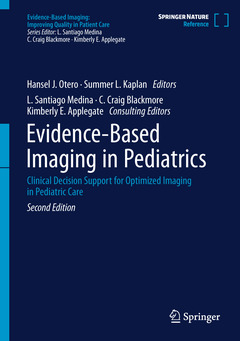Evidence-Based Imaging in Pediatrics (2nd Ed., 2nd ed. 2024) Clinical Decision Support for Optimized Imaging in Pediatric Care Evidence-Based Imaging Series
Coordonnateurs : Otero Hansel J., Kaplan Summer L., Medina L Santiago, Blackmore C. Craig, Applegate Kimberly E

This book provides evidence-based guidance for pediatric imaging to radiologists, pediatricians, and all subspecialists caring for children, as well as policy advocates. While the majority of pediatric radiology books concentrate on diagnosis, this book highlights how imaging should be used in optimal care, allowing comparisons between different modalities and addressing the issue of timing of imaging.
The primary objective of this book is to provide a summary of appropriate imaging use in terms of modality and timing based on the best available evidence. The book therefore acts as a resource for optimized clinical care of children and effective decision-making. A secondary objective is to collate the evidence-based practices that constitute quality care for children in the setting of value-based incentives established by current legislation from United States federal agencies. Radiologists are often in the position of helping clinicians decide when and how to image children with suspected diseases or confirmed diagnoses. However, traditional residency training has done little to fulfill the need for this up-to-date evidence knowledge. Moreover, in spite of furthering subspecialization of the field, the great majority of children?s imaging (and care) occur outside of children?s hospitals, where clinicians and radiologist might need this type of general guidance for establishing best-practices.
The book is divided nine parts, including: non-diagnostic considerations such as safety, value, and quality; organ systems such as musculoskeletal, cardiothoracic, abdominal; and clinical settings, such as prenatal, trauma, and oncology. This new edition incorporates the changes in practice and guidelines in the decade since the first edition was written, especially in fetal imaging. Eighteen new chapters are added, including a new section on pediatric interventional radiology, a topic often excluded by textbooks but necessary for radiologists in general practice and for clinicians managing pediatric illnesses.
This is an ideal guide for radiologists, pediatricians, policy advocates, and all healthcare professionals caring for children.
Date de parution : 10-2024
Ouvrage de 1000 p.
17.8x25.4 cm
Thèmes d’Evidence-Based Imaging in Pediatrics :
Mots-clés :
Evidence-Based; Pediatric; Family Medicine; Imaging; Primary Care; Radiology; Trauma; Tumor; computed tomography (CT); diagnosis



